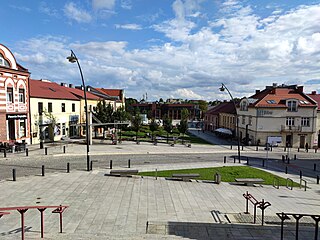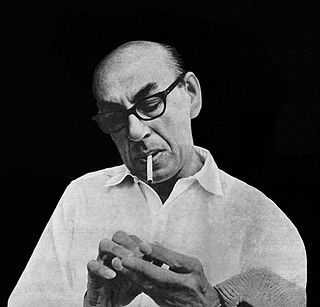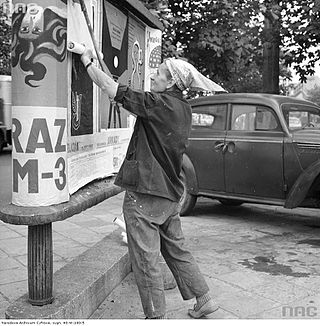
Jaworzno is a city in southern Poland, near Katowice. It lies in the Silesian Highlands, on the Przemsza river. Jaworzno belongs to the historic province of Lesser Poland. The city is situated in the Silesian Voivodeship since its formation in 1999, previously (1975–1999) it was in Katowice Voivodeship. Jaworzno is one of the cities of the 2,7 million conurbation – Katowice urban area and within a greater Silesian metropolitan area populated by about 5,294,000 people. The population of the city is 89,350 (2021).

Stanisław Mateusz Ignacy Wyspiański was a Polish playwright, painter and poet, as well as interior and furniture designer. A patriotic writer, he created a series of symbolic, national dramas within the artistic philosophy of the Young Poland Movement. Wyspiański was one of the most outstanding and multifaceted artists of his time in Poland under the foreign partitions. He successfully joined the trends of modernism with themes of the Polish folk tradition and Romantic history. Unofficially, he came to be known as the Fourth Polish Bard.

Kazimierz Julian Kutz was a Polish film director, author, journalist and politician, one of the representatives of the Polish Film School and a deputy speaker of the Senate of Poland.

Xawery Dunikowski was a Polish sculptor and artist, notable for surviving Auschwitz concentration camp, and best known for his Neo-Romantic sculptures and Auschwitz-inspired art.

The University of Silesia in Katowice is an autonomous state-run university in Silesia Province, Katowice, Poland.

Henryk Tomaszewski was an award-winning poster artist and the "father" of the Polish Poster School.

Silesian Museum in Katowice is a museum in the City of Katowice, Poland.
Józef Mroszczak was a Polish graphic designer and representative of the Polish School of Posters.

Beginning in the 1950s and through the 1980s, the Polish School of Posters combined the aesthetics of painting and the use of metaphor with the succinctness of the poster. By utilizing characteristics such as painterly gesture, linear quality, and vibrant colors, as well as individual personality, humor, and fantasy, the Polish poster made the distinction between designer and artist less apparent. Posters of the Polish Poster School significantly influenced the international development of graphic design in poster art. Influenced by the vibrant colors of folk art, they combine printed slogans, often hand-lettered, with popular symbols, to create a concise metaphor. As a hybrid of words and images, these posters created a certain aesthetic tension. In addition to aesthetic aspects, these posters revealed the artist's emotional involvement with the subject. They did not solely exist as an objective presentation, rather they were also the artist's interpretation and commentary on the subject and on society.
Tadeusz Jodłowski was a Polish artist.
Andrzej Pągowski is a Polish artist who specializes in graphic design and poster art.
Maciej Urbaniec was a Polish artist, graphic designer, poster artist. He was one of the pioneers of the Polish Poster School.

Henoch (Henryk) Barczyński was a Polish painter of Jewish descent, graphic artist, illustrator.

Ludwik Konarzewski – senior was a Polish painter, sculptor and teacher of fine arts who worked in Upper Silesia and Cieszyn Silesia.

Art in Poland refers to all forms of visual art in or associated with Poland.
Hermann Daniel Hermes was a Prussian protestant theologian. Towards the end of his life he became caught up in the campaign for a return to religious orthodoxy pursued by the Rosicrucian politician Johann Christoph von Wöllner, being employed as an "inquisitor" in 1794 in Halle, and elsewhere.

Łukasz Konarzewski, born September 22, 1955 in Istebna, is a Polish historian of art, art restorer, a civil servant of both central and local governmental administration.
Lech Polcyn is a Polish graphic artist, photographer and painter, professor at the Academy of Fine Arts in Kraków.
Urszula Eugenia Broll-Urbanowicz was a Polish painter, animator of underground culture, Buddhist, co-founder of the St-53 Group (1953–56), member of esoteric circle Oneiron (1965-1976), co-initiator and participant of the first Buddhist group in Poland.

Konrad Ksawery Swinarski – Polish theatrical, television, film and opera director and stage designer.













